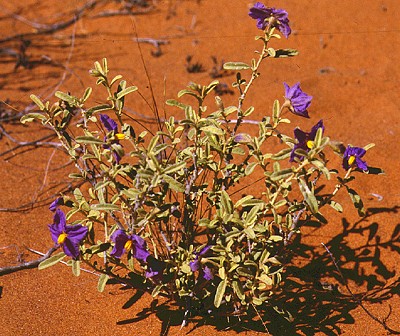
Synonymy
Solanum coactiliferum J. Black, Trans. & Proc. Roy. Soc. S. Austral. 33: 224; t. 14 (1909)
T: Port Broughton district, North of Port Pirie, S.A., 1 Mar. 1909, G.M. Black s.n.; lecto: AD; iso: K, NSW; fide D.E. Symon, J. Adelaide Bot. Gard. 4: 165 (1981); Port Broughton, Aug. 1904, G.M. Black s.n.; syn: AD.
Description
Erect clonal shrub to 30 cm, grey- or silvery-green, densely pubescent with stellate hairs; prickles 2–5 mm long, usually on stems, rare elsewhere.
Leaves oblong, often folded; lamina 1–5 cm long, 3–10 mm wide, sometimes larger, concolorous, entire to slightly undulate; petiole 3–5 mm long, sometimes to 15 mm.
Inflorescence short, 1–6–flowered; peduncle to 10 mm long; pedicels 10–15 mm long, slightly longer in fruit. Flowers 4–5–partite. Calyx 4–8 mm long; lobes triangular, 1–5 mm long. Corolla rotate-stellate, 20–30 mm diam., violet. Anthers 3.5–7 mm long.
Berry depressed-globular, 8–15 mm diam., yellow to yellow-brown, drying brown. Seeds 2–3 mm long, pale brown. n=12.
Bean's more detailed description of this species can also be accessed on the web at http://delta-intkey.com/solanum/www/coactili.htm
Distribution and ecology
Widespread in arid areas of central W.A., southern N.T., S.A. and western N.S.W., extending to south-western Qld and north-western Vic.
Often occurs in sandy loams and on sand dunes.
Specimens from south-western Qld previously assigned by Symon (1981) to S. coactiliferum have been described as a new species, S. ammophilum by Bean (2004).
Common name
Western Nightshade.
Relationships
Closely related to S. esuriale Lindley, from which it is distinguished by the shrubby habit, often slightly recurved prickles, often 4–partite flowers, and often folded leaves.
Considered by Bean (2004) to be a member of the S. esuriale group of subgen. Leptostemonum.
Notes
Treated fruit sometimes eaten by Central Australian Aborigines (see P.K. Latz (1995). Bushfires & Bushtucker. Aboriginal Plant Use in Central Australia. IAD Press, Alice Springs).
A variable species; a form with looser, paler tomentum and more robust leaves occurs between Lake Everard and Lake Gairdner, W.A.; a narrow-leaved form in south-western Qld approaches S. tumulicola Symon; plants in W.A. with shallowly lobed leaves approach S. plicatile (S. Moore) Symon.
Selected specimens
W.A.: N of Warburton Mission, A.S. George 8188 (PERTH). N.T.: NW Simpson Desert, P.K. Latz 4695 (AD, DNA, NT); E of Hermansburg, R.A. Perry 5391 (BRI, CANB, NT). S.A.: near Maralinga, 4 Sept. 1960, H. Turner (AD). N.S.W.: E of Lethero, B.G. Briggs 2788 (NSW).
Plant status, if any
S. coactiliferum is listed on the Advisory List of Rare or Threatened Plants in Victoria - 2005 as Endangered for
Conservation status as a plant of least concern in the
From the web
Further information for this species in WA can be found on the FloraBase site, in NSW on the PlantNET site and for SA on the eFlora site.
Images on the Dave's Garden site appear to be correctly identified as this species as does the image at www.flickr.com/photos/stationalpinejosephfourier/2091462716.






